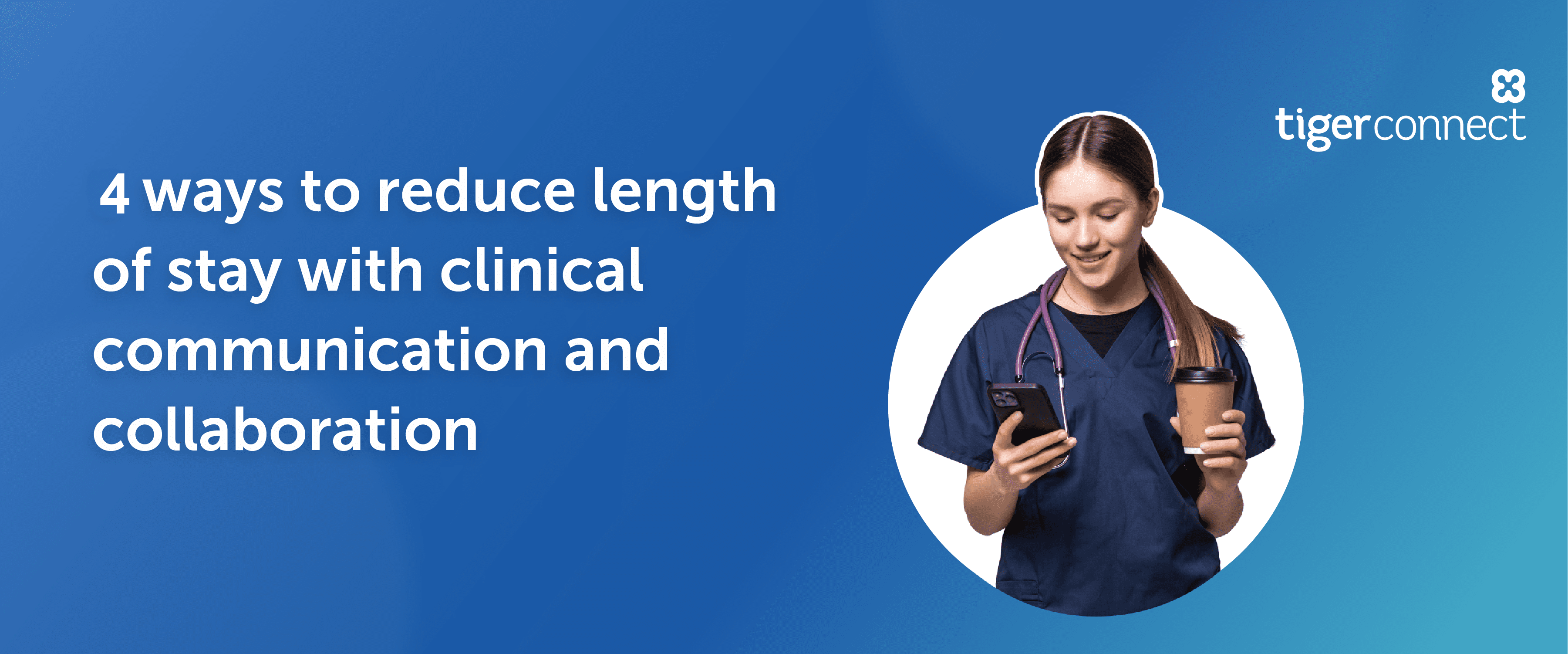Home / Blog /
4 Ways to Reduce Length of Stay with Clinical Communication and Collaboration

4 Ways to Reduce Length of Stay with Clinical Communication and Collaboration
Length of stay (LOS) is one of the most critical measures of a healthcare facility’s operational efficiency. As the Agency for Healthcare Research and Quality (AHRQ) notes, a longer length of stay can lead to a host of unwanted outcomes, from higher costs to negative experiences for both staff members and patients. Additionally, unnecessary time spent in a hospital or acute care facility can result in patient health complications due to infections or falls.
Increased LOS can also have a significant financial impact on hospitals. Consider the following data:
- Each year, the U.S. experiences more than 35 million hospital stays, with an average cost of $11,700 (AHRQ).
- In one acute care facility, the charges for patients experiencing a delay in discharge totaled more than $2.4 million annually, with costs eclipsing $715,000 per year (The Journal of Trauma).
Additionally, higher LOS causes acute care facilities to encounter decreased margins on bundle payments from the Centers for Medicare and Medicaid Services. More issues arise when discharge-ready patients take up a bed that could be occupied by another patient who needs it. Longer stays also create downstream bottlenecks, including crowded emergency departments (EDs), leading to patients seeking care elsewhere and lost revenue.
According to AHRQ, several factors can drive up LOS, including poor organization, delayed decision-making, and cumbersome discharge processes. However, the TigerConnect clinical communication and collaboration solution empowers your healthcare organization to overcome these problems and reduce average LOS without compromising quality.
Care Team Collaboration in One Easy App
To learn more about how TigerConnect improves care team collaboration and communication, request a demo.
|
 |
#1: Streamline Care Team Communication
Every patient in an acute care facility receives services from a web of providers, including primary care physicians (PCPs), specialists, nurses, therapists, and others. When facilities rely on out-of-date communications tools, like pagers and faxes, it’s easy for critical messages to get missed, which leads to delays that can extend a patient’s stay. Cloud-based clinical communication and collaboration tools integrate with existing systems to foster better care team collaboration.
With TigerConnect, your staff will have up-to-date information on every patient – including prompt lab and imaging results. This leads to more informed clinical decision-making and faster consult turnaround times, shortening LOS.
TigerConnect also allows you to create groups and roles to ensure the right team members get the right messages at the right time. You can connect groups to your scheduling system to ensure everyone can find and message on duty or on-call team members.
#2: Increase Alarm Responsiveness and Patient Outcomes
Many care providers encounter an overwhelming number of alerts and alarms each day. For example, one study found that a 66-bed intensive care unit produced two million alerts per month, translating to nearly 200 daily alerts per patient. With an estimated 80 to 99% of alarms being false or clinically insignificant, reducing irrelevant alerts should be a priority for your organization.
When care providers face a deluge of alerts, they may tune out and miss the critical alarms that signal a need for intervention. Delays in responsiveness can lead to poor outcomes, and LOS can be directly affected. Fortunately, TigerConnect Alarm Management and Event Notification ingests alarms from various systems and automatically routes them to the right person – increasing responsiveness to patient needs and emergencies. Your team members will only get the alerts they need and can take action to address them.
#3: Improve Outreach to External Care Providers and Families
As patients near discharge, they will need to have clear follow-up plans in place. This may require coordination of care with facilities, PCPs, home health providers, and patients’ families. Instead of printing documents or scheduling in-person meetings, acute care facilities can use technology to connect.
TigerConnect enables care teams to reach out to anyone in their address books — even if message recipients aren’t using TigerConnect. Individuals receive a link that allows them to connect to a secure message to keep patient privacy protected at all times. Additionally, you can use video conferencing from TigerConnect to make it easy for stakeholders in different locations to discuss the next steps in a patients’ care journey.
#4: Remove Discharge Roadblocks
Discharging a patient requires close coordination across multiple teams — including case management, hospitalists, nursing, outside physicians, and post-acute care facilities. Often, these teams work in different locations and may use various systems, creating silos that stand in the way of efficient discharge.
While many hospitals aim to discharge patients before noon, this doesn’t always happen. Instead, discharges often get clustered in the afternoons or evenings, which can create a mismatch between bed availability and demand, along with ED overcrowding.
With TigerConnect, you can establish groups and workflows to coordinate every task and track the end-to-end discharge workflow. The process kicks off when a physician posts a discharge order — a step that triggers alerts to every discharge team member. When the system detects that each task is complete, it sends a message to transport, with an automated message sent to the patients’ PCP after the patient exits the facility.
Reduce Length of Stay in Your Acute Care Facility with TigerConnect
Acute care facilities know the harm that a high average length of stay can cause. Outdated systems, entrenched processes, and communications silos only magnify the problem. You can overcome these hurdles and lower LOS through improved clinical communication and collaboration.
With automation in healthcare, you can improve care coordination and gain positive benefits — from empowering your professionals to deliver high-quality care and saving costs to improving patient outcomes and experiences. You can improve scheduling, rounding, communications with external providers, and discharge, all factors that can contribute to a shorter average LOS.
Are you looking for ways to reduce your hospital’s length of stay?
The TigerConnect Collaboration suite allows you to streamline workflows, deliver critical alerts and insights to the right providers, and make discharge more efficient. Contact us to learn more.
Will O'Connor M.D., CMIO at TigerConnect
Will O’Connor, M.D. is the Chief Medical Information Officer at TigerConnect. As a physician executive with more than 20 years of healthcare experience, Will is a passionate advocate for rapid advancement across the healthcare industry.
Tags: Length of stay hospital, length of stay acute care hospital, acute care, Patient discharge








